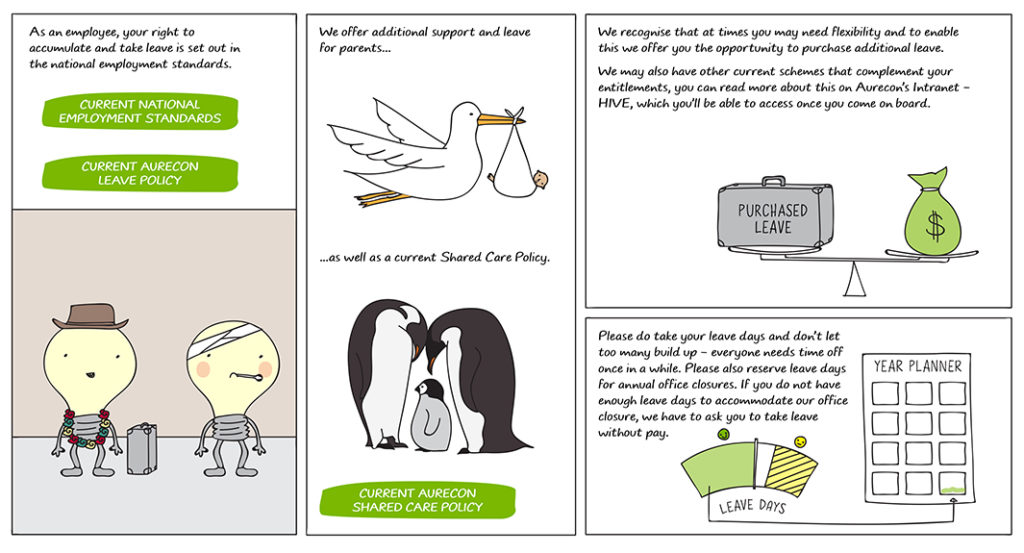Visual contracts, where an employment agreement is conveyed partially or wholly by pictures, are now a thing. What are their benefits and risks?
They say a picture paints a thousand words. In the case of infrastructure consultancy company Aurecon, pictures are the terms of its employment agreements.
Last month, Aurecon became the first company in Australia to introduce ‘visual employment agreements’ across its entire workforce. More than 1200 employees worldwide are expected to sign the agreements before the end of this year.
Liam Hayes, Aurecon’s Global Chief People Officer, said the rationale behind introducing the visual contracts is to avoid the complexities of written agreements. The idea is that if employees can easily understand what they are signing, trust will be built from the beginning of the employment relationship.
 Example of an Aurecon visual employment contract, covering some of their leave policy. Source: Aurecon
Example of an Aurecon visual employment contract, covering some of their leave policy. Source: Aurecon
Visual employment agreements for vulnerable or illiterate workers
While Aurecon has been the first company to roll out visual agreements across its workforce, the idea has been gaining more traction in the context of employing vulnerable or illiterate workers. For example, South African fruit export company Indigo Fruit Growers implemented visual agreements for its fruit pickers who had previously had issues with understanding a written agreement.
Some heavy weights in the legal world are also lending support to visual agreements. Speaking at a conference in December last year, former Chief Justice of the High Court of Australia, Robert French AC said, “There is no reason in principle why pictorial contracts explained orally or supplemented textually or contextually could not be enforceable in the same way as any other contract”.
Potential flaws and issues to consider
Although supportive of the idea of visual contracts, the former Chief Justice admitted that the concept was not without its potential flaws, including how difficult it would be to imagine a counterparty “drawing pictures on the spot to suggest variation of terms”.
The same concerns have been raised by both peak employer and employee bodies. The ACTU and Australian Industry Group have cautioned that visual agreements do not offer employers or employees certainty about respective rights and responsibilities.
In addition to issues of certainty and variation, we think there are some other key issues that businesses should consider before getting out their water colours and felt tips to update their employment agreements:
- Interpretation: Can the picture be interpreted in more ways than one? What amount of supporting text or oral explanation needs to accompany the picture? As with words, pictures are not immune to misinterpretation.
- Consistency: How would you define terms and ensure they are used consistently throughout the agreement? Similarly, how would you ensure that the visual agreement is consistent with written workplace policies and procedures?
- Discrimination: How are employees represented in the pictures? Are they represented in a way that would avoid potential unlawful discrimination claims? Diversity would need to be reflected in the agreement, just as it is in your workforce.
A picture says less than 1000 words
So if visual contracts become popular, where do we draw the line? Pun intended.
In the age of emoticons and gifs, the possibilities seem endless. If an employment agreement itself is a cartoon, will the classic thumbs up emoji in a reply email be adequate acceptance of the terms? Time will tell. Until then, another quote, this time from George Herbert: “Good words are worth much, and cost little”.
Although he probably wasn’t talking about the art of drafting an employment agreement, George Herbert’s words are, in our view, some to live by for any business. Not only will a carefully worded agreement help to ensure things go right, it can also save a lot of time (and money) if things go wrong. So until pictures take over…
Three tips for written employee agreements
- Know your audience: pro-forma employment agreements are useful – they can save time and money and in many cases cover the needs of the business. However, it is important to tailor the agreement to the employee. The new cleaner’s agreement probably won’t need the same restraint of trade clause just signed off by the Chief Information Officer.
- Keep it simple: the rationale for pictorial agreements is that businesses are steering away from having employees sign pages of legalese which they might not understand. This is a very fair point, but agreements don’t have to be complex to be effective. Draft employment agreements in simple, plain English. The easier the agreement is to understand (for everyone, and not just lawyers), the better.
- Keep it compliant: if you’re a National System Employer, your employees will be covered by the National Employment Standards (NES). Any entitlements in an agreement must comply with these standards. There are significant penalties for individuals and companies who do not comply with the NES.
So pictures or paragraphs? Pictures might be edging their way in, but don’t put your keyboards away just yet. Watch this space.
Aaron Goonrey is a Partner and Coral Yopp is a Lawyer in Lander & Rogers’ Workplace Relations & Safety practice. Aaron can be contacted at agoonrey@landers.com.au
Have an HR question? Access online resource AHRI:ASSIST for guidelines, policy templates and checklists on different HR topics topics. Exclusive to AHRI members.

